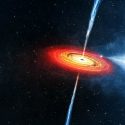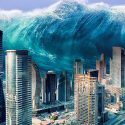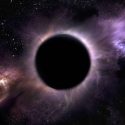The delicate balance of the entire Solar System exists in a gravitational dance between planets. Swap the orbits of two of them and you could end up wreaking all kinds of havoc. What would happen to a rocky, red planet stuck between two gas giants? How would Earth react to a gigantic new neighbor? And why would a big shift in gravity trigger an asteroid apocalypse?
The Sun and Jupiter are the two largest objects in our Solar System. The gravitational forces of these behemoths influence each other’s movements. And they have a big impact on the movements of all the other planets, moons and asteroids in our cosmic neighborhood.
On the inner side of this belt is the fourth planet from the Sun and our neighbor, Mars. The red planet is located a mere 78 million km (49 million mi) from Earth. That means it’s eight times closer to us than Jupiter is.
Jupiter is the 5th planet from the Sun, located at a distance of about 778 million km (484 million mi). And it’s the gas giant’s tremendous force of gravity that could be responsible for the asteroid belt separating the inner and outer regions of the Solar System. So if these two planets suddenly swapped orbits would the millions of rocky objects in the asteroid belt come flying right at us?
Let’s start by checking out how Mars would fare in this orbital switcheroo. It would now be jammed between the gas giants, Jupiter and Saturn. This would put the red planet in the uncomfortable position of having the two biggest planets in the Solar System on either side of it. And it would be uncomfortable because of those gas giants’ gravitational pull.
But the pull would be uneven. And Mars would suffer a similar fate to that of one of Jupiter’s moons, Io. Like Io, Mars would experience a stronger attraction on the side facing Jupiter compared to the side facing away. This would stretch and compress the rocky planet. Mars would start to heat up from the inside.
That’s the reason Io is plagued by more active volcanic eruptions than anywhere else in the Solar System. Place Mars in a similar game of tug-of-war, and the gravitational forces could be strong enough to reactivate a few of its own ancient volcanoes. You could end up seeing lava erupting out of Olympus Mons, the biggest volcano in the Solar System.
Hopping back over to our side of the asteroid belt, things would be getting interesting here on Earth. The first big change you’d notice would be the night sky being a little different. Jupiter would go from appearing as a distant bright star to being about 20% as large as the Moon. Looking up on a clear night, you could see its colorful bands and spots.
But not everything would be swirly and pretty. In its new real estate right next door, Jupiter’s gravitational impact on Earth would be about 64 times stronger than it is now. Jupiter already impacts us from a distance. Every 405,000 years, its pull, along with Venus’, is responsible for droughts and intense rain.
With it being this close, the effect would be more extreme. And the consequences deadly. Caught between the Sun and Jupiter, our planet would experience cataclysmic problems with tidal bulging. So what you once knew as a lovely, habitable home would transition into a volcanic hell. That wouldn’t be the only hell unleashed.
With Jupiter suddenly on the opposite side of the asteroid belt, all those millions of rocks would be pulled in new directions toward it. And that would set more than a few on a crash course with Earth. The objects in the asteroid belt range in size. On the massive side, there’s the dwarf planet Ceres. It’s about 25% the size of our Moon.
Of the asteroids, Vesta is an unwieldy 530 km (329 mi) across. An asteroid wouldn’t even need to be anywhere near that large to hit Earth and trigger the apocalypse. A collision with one as small as 1 km (0.6 mi) could be the end for us. If an asteroid about 10 km (6 mi) across crashed into our planet, it would result in the Sun being blocked out for a year or more.
And without sunlight, we’d experience what’s known as impact winter. Temperatures would drop and photosynthesis would stop. This would all lead to the mass extinction of plant, animal and human life. Thanks, Jupiter. But at least the largest asteroid didn’t collide with Earth. Yet.
Sources
- “Positions And Sizes Of Cosmic Objects”. 2023. lco.global.
- “Planetary Fact Sheet”. 2023. nssdc.gsfc.nasa.gov.
- “Distances Between The Planets Of The Solar System • The Planets”. 2023. theplanets.org.
- “NASA Space Place: What Is The Asteroid Belt? – Vatican Observatory”. Robert Trembley. 2018. vaticanobservatory.org.
- “Jupiter’s Influence – Mission Juno”. 2023. missionjuno.swri.edu.



























